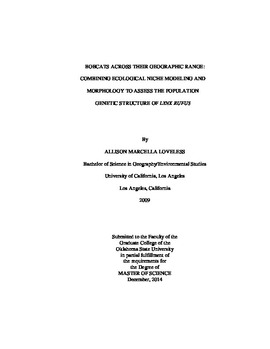| dc.contributor.advisor | Papes, Monica | |
| dc.contributor.author | Loveless, Allison Marcella | |
| dc.date.accessioned | 2016-01-20T15:44:41Z | |
| dc.date.available | 2016-01-20T15:44:41Z | |
| dc.date.issued | 2014-12-01 | |
| dc.identifier.uri | https://hdl.handle.net/11244/25676 | |
| dc.description.abstract | Despite a broad distribution, general habitat requirements, and long dispersal potentials, bobcats <italic>Lynx rufus</italic> exhibit a genetic division that longitudinally transects central North America. I investigated whether (1) the climate of the Last Glacial Maximum (LGM, 21 ka) isolated bobcats into refugia and whether current climate results in reduced gene flow between the segregate populations, and (2) geographic and climatic patterns in cranial morphology reflect population identity. I created ecological niche models to evaluate climatic suitability under historical (LGM) and contemporary conditions, and used two-dimensional geometric morphometric methods to evaluate variations in the cranium and mandible of <italic>L. rufus</italic> across its geographic range. The ecological niche models support a genetic disparity along a longitudinal gradient in the central North America. Models projected onto LGM climate reconstructions provided evidence of increased suitability in the northwest and southeast portions of their range and decreased suitability in the central U.S. that may have created refugia in western and eastern North America during the LGM. Morphological analyses identified a significant linear trend across a longitudinal gradient rather than distinct morphological divergence between lineages. In addition, correlations of morphologies with the principle components of climate variables revealed that precipitation and temperature are most significant predictors of morphological diversity in bobcats. My models suggest that the contemporary Great Plains ecoregion may be restricting bobcat migration and gene flow, effectively maintaining disparate genetic populations. Morphological analyses show that environmental variation may be a larger contributing factor to phenotypic variation than is population identity. By estimating the contemporary and LGM geographic distributions, and quantifying local adaptations, I provided a robust assessment of the biogeographic considerations for population genetic structure of bobcats. | |
| dc.format | application/pdf | |
| dc.language | en_US | |
| dc.publisher | Oklahoma State University | |
| dc.rights | Copyright is held by the author who has granted the Oklahoma State University Library the non-exclusive right to share this material in its institutional repository. Contact Digital Library Services at lib-dls@okstate.edu or 405-744-9161 for the permission policy on the use, reproduction or distribution of this material. | |
| dc.title | Bobcats Across Their Geographic Range: Combining Ecological Niche Modeling and Morphology to Assess the Population Genetic Structure of <italic>lynx Rufus</italic> | |
| dc.type | text | |
| dc.contributor.committeeMember | McBee, Karen | |
| dc.contributor.committeeMember | Tobler, Michael | |
| osu.filename | Loveless_okstate_0664M_13663.pdf | |
| osu.accesstype | Open Access | |
| dc.description.department | Zoology | |
| dc.type.genre | Thesis | |
